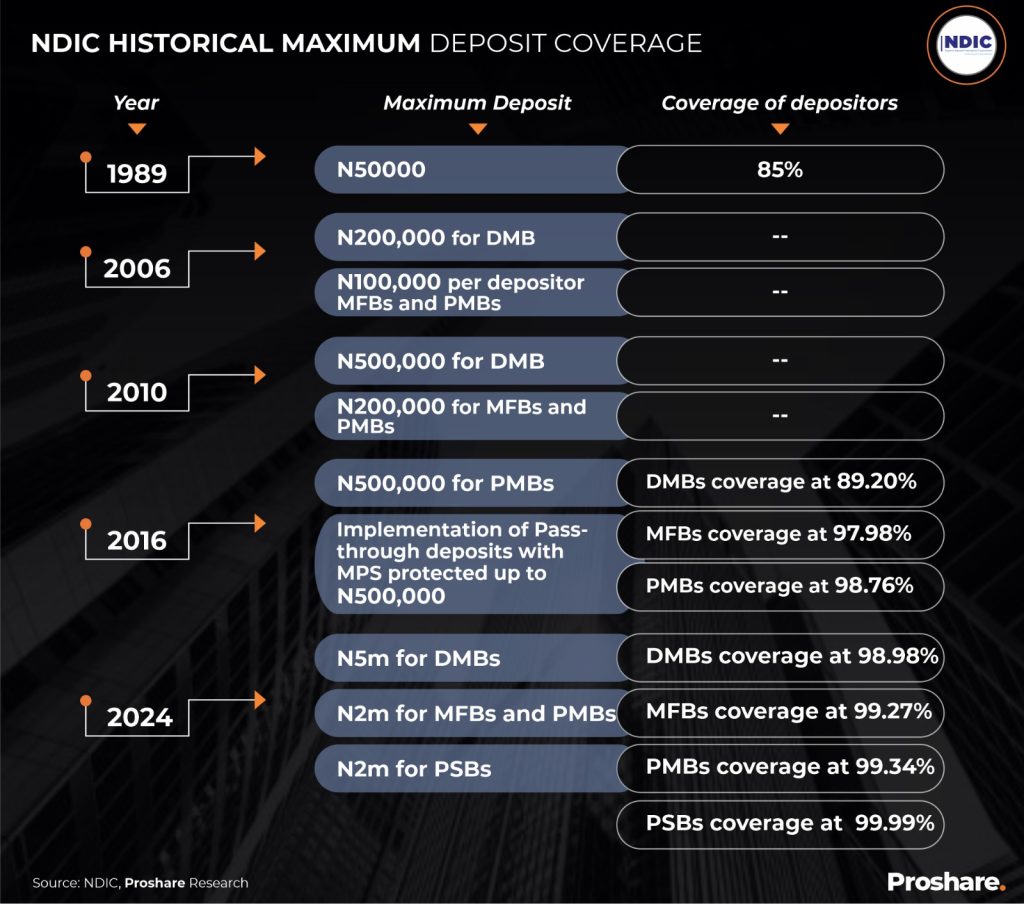NDIC’s N5M Deposit Insurance Protection: Matters Arising

One thing that differentiates a country’s regulated financial operations from their informal or unregistered counterparts is the guarantee of funds in the event of failure or distress in formal financial institutions. Global financial systems have prioritised depositor safety to boost confidence in financial services and promote financial inclusion.

The Nigerian Deposit Insurance Corporation (NDIC) Interim Management Committee (IMC), at the end of its 18th meeting held between April 24 and April 25, 2024, announced an adjustment of the deposit insurance coverage for various categories of deposit-taking financial institutions licenced by the Central Bank of Nigeria (CBN) (see Table 1 below).
Reviewing the NDIC’s new risk protection coverage suggests that about 99% of bank depositors are covered. However, this also implies that 98.98% of Nigerians do not have more than N5mn in their accounts. These depositors also make up only 25.37% of DMB deposits, while 1.02% of DMBs have deposits above N5mn and 74.63% of uncovered deposits. Observers believe it is commendable to see an improvement in the spread of depositors covered by the new deposit protection threshold, but the implication for many deposits largely loaned to industrial enterprises is that they would remain unprotected beyond N5m.

The recent upward review of bank deposit risk protection coverage marks the first review in 8 years, following the last assessment in 2016. The new coverage level is expected to take effect immediately and aligns with the applicable provisions outlined in the NDIC Act (see Illustration 1 below).
Illustration 1:
The Essence of Adjustment
Since the inception of NDIC, the deposit protection coverage limit has been revised four times, from the single coverage of N50,000 for all banks in 1989 to deposit-holding-specific coverage limits. The different coverage limits for DMB, PMB, PSBs, and MFBs have widened depositors’ coverage (89.20% for DMBs, 97.98% for MFBs, and 98.76% for PMBs as of 2023). On average, more than 90% of depositors were insured, with less than 10% uninsured before the newly announced review of maximum deposit insurance on May 2, 2024 (allocating N5m for DMBs, N2m for MFBs, PMBs and PSBs, and N5m for MMOs) (see Table 2 below).
Table 2:
With only 5% of Nigerians having over N500,000 in their bank accounts, according to Nigeria’s Minister of Finance, Mr. Wale Edun, the previous maximum deposit coverage (N500k for DMBs and PSBs, N200k for MFB and PMBs) seemed insufficient to cover a large proportion of depositors. The remaining deposits belong to high net-worth individuals who are mostly consulted and notified before distress turns contagious. There has not been any bank collapse since 2019, as the Central Bank of Nigeria (CBN) has embarked on a forbearance mechanism which swiftly intervenes in sight of fiscal distress (see Table 3 below).
Table 3:
Total bank deposit risk protection coverage remains below 45% of deposits despite the upward review of the insurable maximum deposit; the margin of uninsured deposits is relatively no different from the past. Furthermore, based on the CBN’s 45% Cash Reserve Ratio, only 55% of deposits are technically exposed to payment default risk. While analysts believe that the CBN CRR is subject to changes based on new economic indicators, the current average depositor’s coverage of 90% is sufficient to absorb any future change. The revised maximum deposit risk protection limit will raise the banks’ annual NDIC premium.
Analysts and Market Expectations
Financial analysts have supported the NDIC adjustment in deposit insurance coverage, arguing that such a review enhances public confidence, promotes financial system stability, and encourages financial inclusion.
According to Prof. Uche Uwaleke of the Institute of Capital Market Studies (ICMS), the increase in deposit insurance coverage is primarily designed to protect depositors in the event of bank failure and so has the potential to boost confidence in the banking industry. “Today, the CBN is concerned about the rising currency circulating outside the banks, which is largely due to waning confidence. So, the performance of banks in the medium to long term will improve with more cash returning to the banks on account of this timely development against the backdrop of the ongoing banking sector recapitalisation.”
“A larger coverage level reduces the likelihood of bank runs, thereby strengthening financial system stability. I do not doubt that the overall economic impact will be positive. Don’t forget, the last time this was reviewed for DMBs from 200k to 500k was in 2011, and the impact of inflation and naira depreciation over the years have made another review Imperative.”
Improved confidence in the banking sector will encourage more people to deposit money in banks. A coverage level of over 98% for DMBs implies that nearly all bank depositors will receive full amounts in the event of bank failure, which will positively impact financial inclusion.
The size of a bank’s premium is a function of its risk level: the higher the risk level based on some quantitative and qualitative criteria determined by the NDIC, the higher the premium. Any increase in the deposit insurance premium paid by banks following the increase in deposit Insurance coverage may not be significant because the NDIC no longer uses a flat rate in computing the premium but a differential premium assessment, which is risk-based and anchored on prudential thresholds for banks. These regulatory thresholds cover capital Adequacy, asset quality and liquidity ratios.
In a WebTV EcoPol programme, Mr Johnson Chukwu, the Managing Director of Cowrie Assets Limited, noted that banks appear insulated from the current economic crisis as bellwethers of the economy. With banks declaring billions of naira in profit, some seeing earnings increase between 200 and 300%, and a rise ll in the size of transaction tickets caused by the fall in the external value of naira, it is reasonable to increase deposit insurance coverage because the bank’s total balance sheet sizes have grown to trillions of naira.
The marginal increase in the deposit insurance premium will not hurt the banks’ bottom line because it is a tax-deductible expense and will be inconsequential because of the size of the bank’s earnings.
The impact on their profits will be minimal, given that they enjoy increased net margins, higher commissions and fees, and the windfall effects of devaluation, which every other sector suffers. An NDIC insurance premium increase may be inconsequential to banks.
A probable NDIC readjusted deposit premium will encourage banks to convert more customers, and the incidence of default will decline in proportion to the size of their balance sheets. Analysts note that bank failures are not caused by the number of customers but by the size of non-performing loans.
Closing Thoughts
The adjustment in NDIC deposit insurance protection coverage has elicited commendations from analysts, who believe it is a pivotal step towards protecting depositors and instilling confidence in the banking industry. Against the concerns over rising currency circulation outside the banking system, attributable to low confidence in the financial system, the revised insurance coverage could see the return of hoarded cash to banks, thereby improving their performance in the medium to long term, especially amidst ongoing banking sector recapitalisation efforts.
The differential premium assessment system in computing insurance premiums should ensure that banks bear an appropriate share of risk, aligning with prudent banking practices and safeguarding the integrity of the financial sector amidst evolving economic dynamics. However, analysts worry that, regardless of the risk-based approach, the adjustment will increase the absolute value of NDIC charges and hit banks’ profits together with the CRR (at 45%), AMCON Charges (0.5% of assets and contingents), and SLF (at 24.75% MPR + 100bps).
Overall, analysts believe that the marginal increase in deposit insurance premiums, anchored on the differential premium assessment framework, is unlikely to significantly impact banks’ bottom lines. Banks’ declaration of huge profits after tax means the incremental cost incurred through insurance premiums will probably remain manageable.



